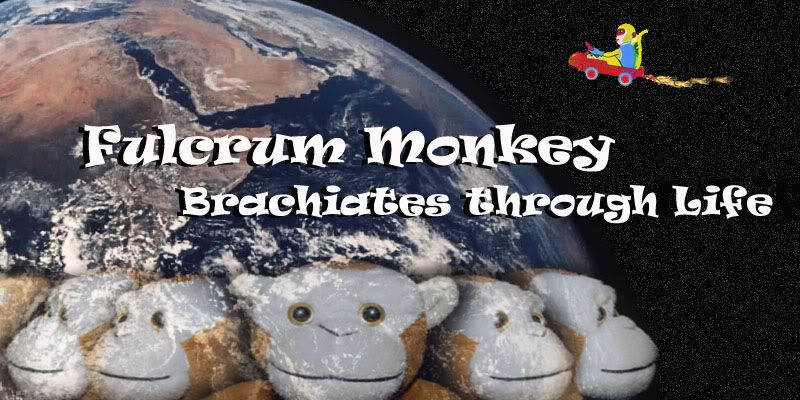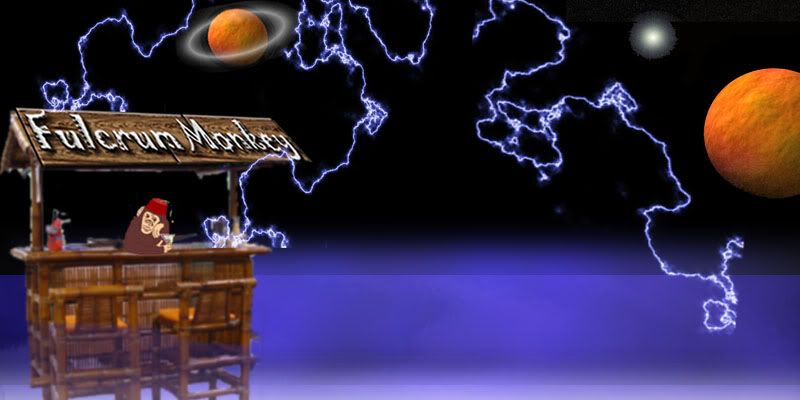Notary Republics in the Service of Death
My stress ball wake up call from the central nervous system came at five a.m. instead of three a.m. today. Just like MODOT, progress as promised. Odd, I woke up just in time to celebrate an anniversary, my literary and historical notes daily email tells me that, “It was on this day in 1945 that the first atomic bomb was exploded at 5:30 a.m., one hundred and twenty miles south of Albuquerque, New Mexico.”
I’ve actually been to the bomb site in White Sands, New Mexico. I was a photographer for a class called Nuclear Fiction taught by my friend Bob. He had spent the last fifteen years of his life researching the impact of the bomb on our culture and has written a book about the same. Somehow he managed to get us an invitation to see what is generally off limits.
White Sands is still an active missile test site so the national park marker next to the base of what was the detonation tower doesn’t get many visitors. On the drive in, we were pulled over by the military. The road in front of us had been closed. We watched a small smoke plume streak across the sky, felt the impact from a test explosion, and then we were cleared to proceed right through the testing range.
We saw several things that day: the blast site, the farm house where the bomb was assembled, and the EMP trestle. The EMP trestle is an enormous wooden platform with two towers at either end. An atomic explosion is accompanied by an electro magnetic pulse that can knock out a plane’s electrical system, causing it to crash. The EMP trestle was built so that planes could be wheeled out onto it in simulation of flight. Then the planes could be hit with an electromagnetic pulse generated by the two towers.
There is no metal in the mammoth, multi-story platform, not a single nail or bolt, as they could interfere with the tests. Our tour guide told us that at the time they weren’t able to make a plane that could handle the pulse and eventually the trestle was simply abandoned. I really should post my pictures of this. I shot everything in black and white and there’s a cold war feel to all of the images.
I’ve felt connected to the bomb from a young age. My oldest brother Phil is an engineer and physicist. He taught me to read well before kindergarten and the first book I read by myself was The How and Why Book of Nuclear Science. It was a young adults primer on how to be a good scientist when you grow up and it was filled with accounts of the development of the bomb that were more Tom Swift and Nancy Drew than hard science.
This large format book was the sort of publication that Americans made after Sputnik flew over, where it was perceived that the Russians were beating us in math and science so we needed to excite more children about engineering, war and the like. I can recall two things from the book: the first hand account of the flight over Hiroshima and a detailed account of the Chicago underground tennis courts where they’d managed the first chain reaction. There is no fine line between education and propaganda, kindergarten and Joseph Goebbels are both German exports.
There’s a scene in the HBO series Six Feet Under where the Brenda character explains her general nihilism (also German) and self-destructive tendencies in terms of the bomb. She says that she always assumed that nuclear war was not an “if” but a “when”. The sentiment tracks as, “if everything is going to go, does anything matter?” I felt that way for a long time: a sort of dark certainty that while I was smart enough, or well informed enough, to be in on the cosmic joke, I was powerless to stop it.
Mutually assured destruction, either accidental or intended, seemed so inevitable to me that I found the return to more conventional warfare surprising. I shouldn’t say return, as we haven’t really stopped fighting wars for very long, have we? With Russia as the big “other” all our little wars seemed like side pots in international poker. We even pulled a P.T. Barnum by calling them, “Police Actions”. Sans Russia, the side pots have been elevated to all-in Texas hold um pots. Unfortunately, our militarism seems to be making more enemies than it defeats. Hearts and minds are hard hills to hold.
Many of the kids I educate next year will go off to war and some of them won’t come back. I’m really not sure how to follow a sentence like the last one. I have a kid in one of my classes now with the last name Snowden and every time I take attendance I flash back to Yossarian in Catch-22 trying to hold in Snowden’s intestines as the kid slowly dies from the shrapnel wound.
From T.S. Elliot’s The Hollow Men:
This is the way the world ends
This is the way the world ends
This is the way the world ends
Not with a bang but a whimper.
I’m sitting in my air conditioned office worried about a house deal while many of my peers are in harms way. A man I used to tend bar with, Will, was killed over a year ago by a roadside bomb in Iraq. I wonder sometimes wonder about his new wife and his old best friend, how they are managing with his loss. With a “volunteer” military one has to accept and honor life choices and service with gratitude. There is no reasoning with death.
Extinction of a species has been described by environmentalist Eugene Linden as, “the death of birth.” The only positive I can see in this scenario is that in extinction there are no new generations to repeat the folly of their forbearers. White Sands, for all its kitsch and Americana cache, seems rhetorically to be the converse of the environmentalist’s dictum: it’s the birthplace of a new kind of death. Today is the birthday of that kind of death, as many of the men who served as midwives were themselves slowly consumed by cancers and of course thousands of people in Hiroshima and Nagasaki were incinerated soon after the first test. If humans ever manage their own "death of birth" it seems probable that these bombs will be involved.
I’ve been to the delivery room, the New Mexican basin, where the white sand was fused into a kind of green glass called Trinitite by the heat of the blast. I’ve touched the glass and while I used to feel like Brenda, powerless in the face of personal or mass annihilation, I’ve learned that being a witness is doing something. To see and to tell what you’ve seen is perhaps the only hope. Like Gregory Corso in his classic poem Bomb, I sing you A-bomb on this your birth of death. Can I get a witness?




0 Comments:
Post a Comment
<< Home